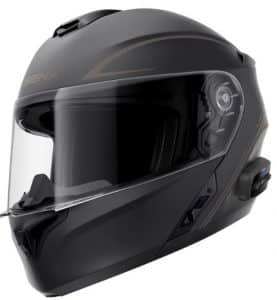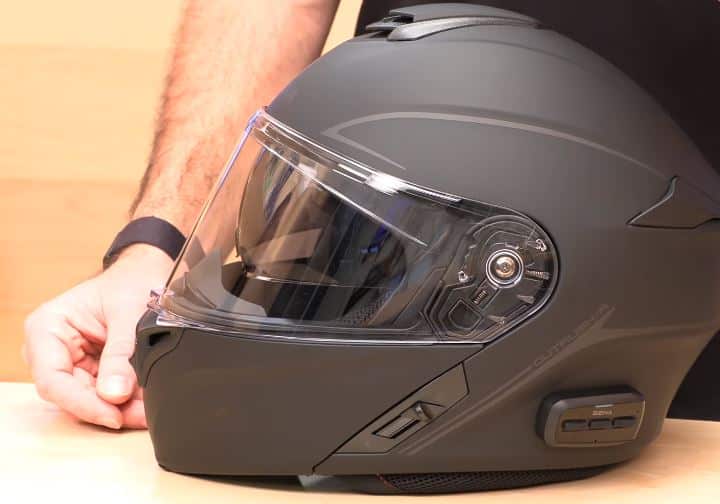With everyone hooked on tech advancements, the Sena Impulse vs. Outrush R debate is heating up. Both modular helmets weigh around 1,760g (3.85 lbs.) in medium size, but the real differences come down to their shell material, intercom systems, ECE 22.05 configurations, and of course, pricing.
The Sena Impulse, constructed with a fiberglass shell and Pinlock-ready, is certified under the ECE 22.05P standard, indicating approval for a protective lower face cover (chin bar) when closed. It’s equipped with both built-in Bluetooth 5.0 and Mesh 2.0 intercom technology, offering versatile communication options.
Conversely, the Sena Outrush, which is incompatible with Pinlock inserts, features a polycarbonate ABS shell and carries the ECE 22.06P/J rating, signifying approval for both open and closed chin bar configurations, albeit with a detachable headset fitted only with Bluetooth 5.0 intercom technology, catering to more basic communication needs.
Despite their differences, the Sena Outrush R is available at a reduced price of around $300, making it an appealing option for budget-conscious riders.
Sena Impulse vs. Outrush R Differences
| Sena Impulse | Sena Outrush R | |
|---|---|---|

Buy on RevZilla | Amazon | 
Buy on RevZilla | Amazon |
|
| Specifications: | Specifications: | |
| ● Shell Material: Composite Fiberglass ● Outer Shell Sizes: 2 (S/M/L) (XL/2XL) ● Shape: Intermediate Oval ● Weight: Appx. 3.87 lbs., 61 oz, 1760g Medium Size ● Color: Matte Black/Glossy White ● Helmet Certifications: DOT, ECE 22.05 (Homologation P) ● Bluetooth Version: 5.0 ● Bluetooth Intercom Distance: Up to 2 km (1.2 miles) ● Bluetooth Intercom Riders: 4 Riders ● Bluetooth Intercom Talk Time: Up to 18 Hours ● Mesh Intercom Distance: Up to 2 km (1.2 miles), Extendable to 8 km (5 miles) ● Open Mesh Intercom: Virtually Limitless ● Group Mesh Intercom: 24 Riders ● Mesh Intercom Talk Time: Up to 11 Hours | ● Shell Material: Polycarbonate ABS ● Outer Shell Sizes: 2 (S/M/L) (XL/2XL) ● Shape: Intermediate Oval ● Weight: Appx. 3.85 lbs., 61.6 oz, 1730g Medium Size ● Color: Matte Black/White ● Helmet Certifications: DOT, ECE 22.05 (Homologation P/J) ● Bluetooth Version: 5.0 ● Bluetooth Intercom Distance: Up to 0.9 km (0.56 miles) ● Bluetooth Intercom Riders: 4 Riders ● Bluetooth Intercom Talk Time: Up to 12 Hours |
Having had the opportunity to wear both the Sena Impulse and the Outrush R helmets, with the Impulse launched in 2022 and the Outrush R replacing the 2020 Outrush in 2021, I’ve noted several distinctions between the two models based on my firsthand experiences:
Voice Communications System (Intercom)

The Sena Outrush R relies solely on Bluetooth for its intercom functionality, unlike the Mesh-compatible Sena Impulse, accommodating a MultiWay Conference Intercom with up to three recently paired devices. The Universal Intercom feature also permits pairing with non-Sena Bluetooth headsets that support the Bluetooth Hands-Free Profile (HFP), although only one non-Sena unit can be paired at a time.
Should another Bluetooth device be connected using Second Mobile Phone Pairing, it will disconnect the non-Sena headset. Thankfully, the Sena Utility App simplifies this process with Smart Intercom Pairing—simply scan a QR code on your buddy’s phone to connect.
Similarly, the Sena Impulse employs Bluetooth intercom technology. But like the Outrush R, its BT doesn’t connect with the latest Mesh protocols, even if all users are using Sena devices. To address this limitation, the Impulse integrates Mesh 2.0 intercom technology, ensuring compatibility for joining larger group Mesh intercom sessions of up to 24 riders. The Multi-Channel Open Mesh Intercom mode further enhances versatility by supporting virtually limitless riders.
One common issue with Bluetooth-only helmets is the difficulty in connecting them to others for intercom use, often requiring manual intervention and wasted time. And if riders get separated, the connection drops until manually reconnected, and the units must stay in a specific line together. In contrast, Mesh intercom automatically reconnects if riders come back into range, allowing for greater flexibility within the group. Riders can move around freely without affecting the call, making coordination easier, such as the lead rider becoming the sweep without disrupting the call group.
Intercom Working Distance and Talk Time

In terms of Bluetooth Intercom range, the Sena Outrush R falls short compared to the Impulse. Specifically, the Outrush offers a connectivity range of up to 0.9 km (0.56 miles), whereas the Impulse has a longer range of up to 2 km (1.2 miles). Moreover, the Impulse provides additional mesh connectivity, extending up to 2 km (1.2 miles) and can be further expanded to an impressive 8 km (5 miles).
As for talk time, the Impulse definitely outlasts the Outrush R with up to 18 hours of Bluetooth intercom talk time and up to 11 hours of Mesh intercom talk time, keeping the conversation going longer. In comparison, the Outrush R offers up to 12 hours of Bluetooth intercom talk time. The difference boils down to the battery capacity in each unit, with the Impulse featuring a non-replaceable 1,300 mAh (lithium polymer) battery, while the Outrush R features a replaceable 1,200mAh (lithium polymer) battery.
Outer Shell
The outer shell of the Sena Outrush R utilizes PC-ABS material, a blend of polycarbonate (PC) and acrylonitrile butadiene styrene (ABS), while the Sena Impulse opts for pure fiberglass, a composite material with glass fibers set in a polyester matrix.
While fiberglass, with its tensile strength ranging from 20,000 to 60,000 psi, may not match the raw strength of carbon fiber or Kevlar, its superior elasticity allows it to flex and absorb impacts without fracturing. Making it an excellent choice for mid-priced helmets (including the Impulse at $599.00), offering enhanced protection compared to polycarbonates and easier handling than carbon fiber.
In contrast, PC-ABS provides a more cost-effective alternative (with the Outrush R costing $299.00) to pure PC. With a tensile strength of approximately 5,900 psi, it delivers notable stiffness, high heat resistance (up to 110°C at 66 psi), and outstanding impact resistance, even in low-temperature conditions. Moreover, it retains its shape over time and lends itself well to helmet molding processes.
But PC-ABS isn’t perfect—it lacks the weather resistance and durability of fiberglass, and its UV and chemical resistance are somewhat limited. To address these shortcomings, some helmets, like the LS2 Advant, incorporate fiber fillers as reinforcing agents, while others introduce thermoplastic additives for improved performance, as seen in the HJC i90.
Pinlock Ready

One effective way to prevent condensation from forming on the inside of the visor, aside from adjusting the vents or opening the visor itself, is by using a Pinlock anti-fogging insert. But not all helmets are compatible with Pinlock inserts, and this includes the Sena Outrush R. On the other hand, the Sena Impulse is Pinlock ready and even includes a Pinlock Fog Resistant (Clear) 120 lens in the box.
The snug fit of the Sena Impulse around the neck, coupled with flush-mounted or low-profile inserts and chin skirt, minimizes air entry into the helmet, reducing noise. While this design effectively prevents air from entering, it can also trap hot air inside, increasing the likelihood of condensation forming. The hydrophilic nature of the insert enables it to absorb moisture from your breath, preventing condensation from forming on its surface.
Pinlock offers various performance levels of inserts, including Pinlock 30, Pinlock 70, Pinlock 120 (commonly used in racing or adventure riding where temperature differentials might be greater), and Pinlock Evo, which by the way, is essentially a rebranding of Pinlock 120 inserts specifically used in Shoei helmets. The higher the number, the more absorbent and effective the insert is at preventing fogging.
| Pinlock Type/Criteria | Pinlock 30 | Pinlock 70 | Pinlock 120 | Pinlock Evo |
|---|---|---|---|---|
| Standard | Standard | Entry Level | Mid-Range | Professional |
| Lens Fit | One Fit | Custom | Custom | Custom |
| Fog Resistant Level | Good | Strong | Extreme | Extreme |
| Colored Lenses | Not Available | Available | Available | Available |
| 100% Max Vision | Not Available | Available | Available | Available |
The Pinlock insert’s bead, which runs around its edge, prevents it from coming into contact with the external visor, creating a double-glazing effect. By keeping the insert separated from the visor, it remains warmer, minimizing the potential for fogging even in cold conditions.
ECE 22.05 Homologations

It’s important to note that the European ECE 22.05 motorcycle helmet testing regulations do not hold legal weight in the US. And the designations ECE 22.05P and ECE 22.05P/J specifically pertain to modular/flip-up helmets.
These designations indicate that a modular helmet has undergone testing and received approval to provide protection in various configurations: with the chin bar down, up, or both. While not legally binding in the US, it’s still valuable information to consider, as we all want assurance that our modular helmets offer adequate protection in all configurations.
In the case of the Sena Impulse, it’s engineered to provide protection with the chin bar down, functioning as a full-face helmet. As a result, it receives type P certification for protective face covering, labeled as ECE 22.05P. In contrast, the Sena Outrush R holds dual-homologation (P/J homologated), indicating it has been tested and approved for use with the chin bar up (J certification), resembling an open-face or jet-style helmet, as well as with the chin bar closed (P certification). The dual certification is denoted by ECE 22.05P/J.
Pricing
As of the time of writing this comparison, the Sena Outrush R Bluetooth helmet was available for purchase at $299.00, whereas the Sena Impulse Modular Mesh Intercom helmet was priced at $599.00. This reflects a $300 price disparity, largely attributed to the enhanced features present in the Impulse model.
These include the Mesh intercom functionality, Wi-Fi connectivity, premium speakers and microphone by Harman Kardon, integrated LED taillight for heightened visibility, and the employment of a more advanced composite fiberglass outer shell material, features that the Sena Outrush R lacks.
Sena Impulse and Outrush R: Quick Reference Guide for Operations and Commands
| Operation | Button Command |
| Turn on | Hold Center and (+) Buttons for 1 second |
| Turn off | Tap Center and (+) Buttons |
| Adjust volume | Tap (+) or (-) Buttons |
| Answer call | Tap Center Button |
| End call | Hold Center Button for 2 seconds |
| Voice dial | Hold Center Button for 3 seconds |
| Speed dial | Hold (+) Button for 3 seconds |
| Reject call | Hold Center Button for 2 seconds |
| Play/Pause music | Hold Center Button for 1 second |
| Skip tracks | Hold (+) or (-) Button for 1 second |
| Pair intercom | Hold Center Button for 5 seconds |
| Start/End intercom | Tap Center Button |
| Turn radio on/off | Hold (-) Button for 1 second |
| Select preset | Hold Center Button for 1 second |
| Seek forward/backward | Double tap (+) or (-) Button |
| Scan FM band | Hold (+) Button for 1 second |
Michael’s Summary and Conclusion

I've diligently categorized my motorcycle gear recommendations into all available categories, with the aim of providing you with a comprehensive analysis that showcases the absolute best options for all your needs. These items are the culmination of in-depth research, extensive testing, and personal use throughout my vast experience of 50+ years in the world of motorcycling. Besides being a passionate rider, I've held leadership positions and offered consultancy services to reputable companies in over 25 countries. To See Top Picks and the Best Prices & Places to Buy: Click Here! |
Information for this article was partially sourced and researched from the following authoritative government, educational, corporate, and non-profit organizations:
Ni/A













